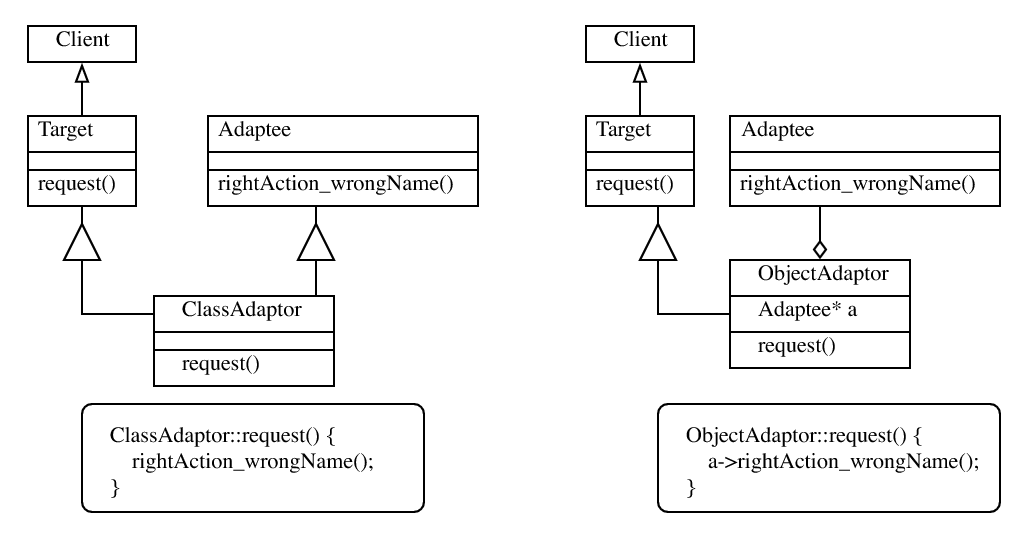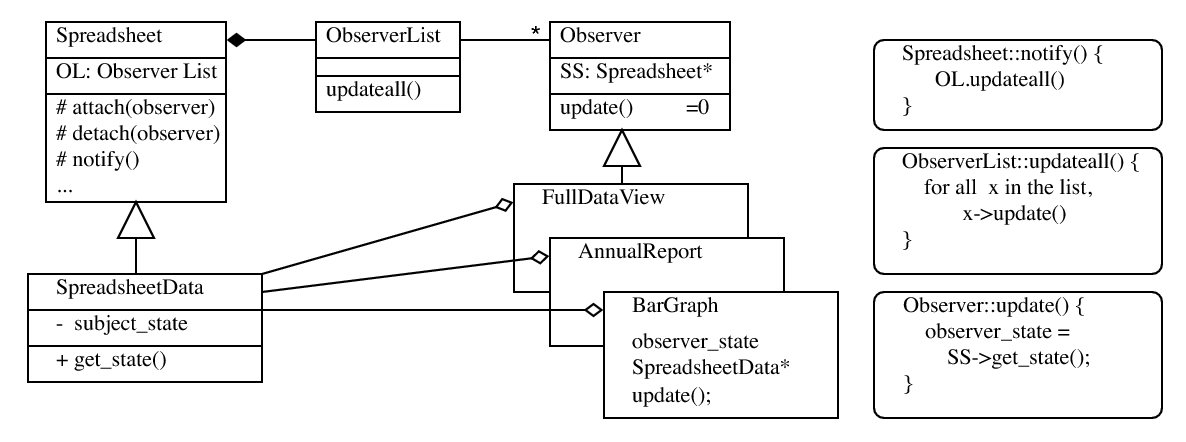
CPSC 427a: Object-Oriented Programming
Michael J. Fischer
Exceptions (cont.)
C++
exception
mechanism
(recall)
C++ exception mechanism is a means for a low-level routine to report an
exception directly to a higher-level routine.
This separates exception-handling code from normal processing
code.
An exception is reported using the keyword throw.
An exception is handled in a catch block.
Each routine in the chain between the reporter and the handler is exited cleanly, with all destructors called as expected.
Throwing an exception
throw is followed by an exception value.
Exceptions are usually objects of a user-defined exception type.
Example:
throw AgeError("Age can’t be negative");
Exception class definition:
Catching an exception
A try region defines a section of code to be monitored for exceptions.
Immediately following are catch blocks for handling the exceptions.
What kind of object should an exception throw?
catch filters the kinds of exceptions it will catch according to the type
of object thrown.
For this reason, each kind of exception should throw it’s own type of
object.
That way, an exception handler appropriate to that kind of exception can
catch it and process it appropriately.
While it may be tempting to throw a string that describes the error
condition, it is difficult to process such an object except by printing it
out and aborting (like fatal()).
Properly used, exceptions are much more powerful than that.
Standard exception class
The standard C++ library provides a polymorphic base class std::exception from which all exceptions thrown by components of the C++ Standard library are derived.
These are:
| exception | description |
| bad_alloc | thrown by new on allocation failure |
| bad_cast | thrown by a failed dynamic_cast |
| bad_exception | thrown when an exception type doesn’t match any catch |
| bad_typeid | thrown by typeid |
| ios_base::failure | thrown by functions in the iostream library |
(from http://www.cplusplus.com/doc/tutorial/exceptions/)
Catching standard exceptions
Class std::exception contains a virtual function
const
char*
what()
const;
that is overridden in each derived exception class to provide a meaningful
error message.
Because the base class is polymorphic, it is possible to write a single
catch handler that will catch all derived exception objects.
Example:
Deriving your own exception classes from std::exception
Multiple catch blocks
Rethrow
A catch block can do some processing and then optionally rethrow the exception or throw a new exception.
Note: Rethrowing the current exception is not the same as a new throw with the same exception object.
Throw restrictions
It is possible to specify that a function can only throw certain kinds of
exceptions (or none at all).
This “feature” is regarded as a bad idea because the current semantics
are not what one would expect.
It does not prevent the exceptions from being thrown; rather, it causes a run-time test to be inserted which calls unexpected_exception() when an exception is thrown that is not listed in the function’s throw specifier.
Uncaught exceptions: Ariane 5
Uncaught exceptions have led to spectacular disasters.
The European Space Agency’s Ariane 5 Flight 501 was destroyed 40
seconds after takeoff (June 4, 1996). The US$1 billion prototype rocket
self-destructed due to a bug in the on-board guidance software.
[Wikipedia]
This is not about a programming error.
It is about system-engineering and design failures.
The software did what it was designed to do and what it was agreed that it should do.
Uncaught exceptions: Ariane 5 (cont.)
Heres a summary of the events and its import for system engineering:
As the result of the unanticipated failure mode and a diagnostic message erroneously treated as data, the guidance system ordered violent attitude correction. The ensuing disintegration of the over-stressed vehicle triggered the pyrotechnic destruction of the launcher and its payload.
Termination
There are various conditions under which the exception-handling mechanism can fail. Two such examples are:
When this happens, the function terminate() is called, which aborts
the process.
This is a bad thing in production code.
Conclusion: All exceptions should be caught and dealt with explicitly.
Design Patterns
General OO principles
What is a design pattern?
A pattern has four essential elements.1
Adaptor pattern
Sometimes a toolkit class is not reusable because its interface does not
match the domain-specific interface an application requires.
Solution: Define an adapter class that can add, subtract, or override functionality, where necessary.
Adaptor diagram
There are two ways to do this; on the left is a class adapter, on the right an object
adapter. 
Indirection
This pattern is used to decouple the application from the implementation
where an implementation depends on the interface of some low-level
device.
Goal is to make the application stable, even if the device changes.
Proxy pattern
This pattern is like Indirection, and is used when direct access to a
component is not desired or possible.
Solution: Provide a placeholder that represents the inaccessible
component to control access to it and interact with it. The placeholder
is a local software class. Give it responsibility for communicating with
the real component.
Special cases: Device proxy, remote proxy. In Remote Proxy, the system must communicate with an object in another address space.
Polymorphism pattern
In an application where the abstraction has more than one
implementation, define an abstract base class and one or more
subclasses.
Let the subclasses implement the abstract operations.
This decouples the implementation from the abstraction and allows multiple implementations to be introduced, as needed.
Polymorphism diagram
Controller
A controller class takes responsibility for handling a system event.
The controller should coordinate the work that needs to be done and
keep track of the state of the interaction. It should delegate all other
work to other classes.
Three kinds of controllers
A controller class represents one of the following choices:
Choose among these according to the number of events to be handled, cohesion and coupling, and to decide how many controllers there should be.
Bridge pattern
Bridge generalizes the Indirection pattern.
It isused when both the application class and the implementation class
are (or might be) polymorphic.
Bridge decouples the application from the polymorphic implementation, greatly reducing the amount of code that must be written, and making the application much easier to port to different implementation environments.
Bridge diagram
In the diagram below, we show that there might be several kinds of
windows, and the application might be implemented on two operating
systems. The bridge provides a uniform pattern for doing the
job.
Subject-Observer or Publish-Subscribe: problem
Problem: Your application program has many classes and many objects
of some of those classes. You need to maintain consistency among the
objects so that when the state of one changes, its dependents are
automatically notified. You do not want to maintain this consistency by
using tight coupling among the classes.
Example: An OO spreadsheet application contains a data object, several presentation “views” of the data, and some graphs based on the data. These are separate objects. But when the data changes, the other objects should automatically change.
Subject-Observer or Publish-Subscribe: pattern
Call the SpreadsheetData class the subject; the views and graphs are
the observers.
The basic Spreadsheet class composes an observer list and provides an
interface for attaching and detaching Observer objects.
Observer objects may be added to this list, as needed, and all will be
notified when the subject (SpreadsheetData) changes.
We derive a concrete subject class (SpreadsheetData) from the Spreadsheet class. It will communicate with the observers through a get_state() function, that returns a copy of its state.
Subject-Observer or Publish-Subscribe: diagram

See textbook for more details.
Singleton pattern
Suppose you need exactly one instance of a class, and objects in
all parts of the application need a single point of access to that
instance.
Solution: A single object may be made available to all objects of class C
by making the singleton a static member of class C.
A class method can be defined that returns a reference to the singleton if access is needed outside its defining class.

Example: Suppose several parts of a program need to use a StringStore.
We might define StringStore as a singleton class.
The StringStore::put() function is made static and becomes a global access point to the class, while maintaining full protection for the class members.